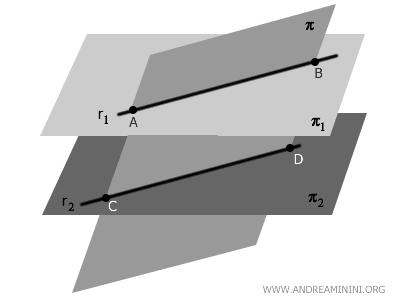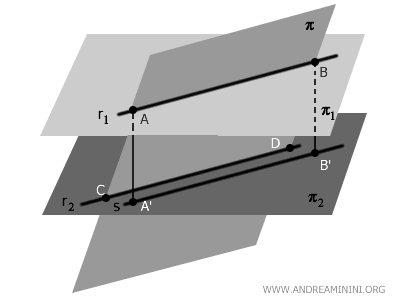Theorem of Parallel Planes Intersected by a Third Plane
When a plane \( \pi \) intersects two parallel planes \( \pi_1 \) and \( \pi_2 \), the intersections are two parallel lines \( r_1 \) and \( r_2 \).

This happens because \( \pi_1 \) and \( \pi_2 \) are parallel and equidistant, so the plane \( \pi \) cuts through them, forming two lines \( r_1 \) and \( r_2 \).
Since \( \pi \) meets both planes at the same angle, the lines \( r_1 \) and \( r_2 \) are parallel to each other.
Proof
Let us examine two parallel planes \( \pi_1 \) and \( \pi_2 \).
By definition, the distance between \( \pi_1 \) and \( \pi_2 \) remains constant, and their normal vectors are proportional.
A third plane \( \pi \) intersects \( \pi_1 \) along the line \( r_1 \) and \( \pi_2 \) along the line \( r_2 \).

Because \( \pi_1 \parallel \pi_2 \), the plane \( \pi \) intersects both planes while maintaining the same angle of intersection.
The lines \( r_1 \) and \( r_2 \) lie within the same plane \( \pi \), which makes them coplanar.
Now, consider two points \( A \) and \( B \) on \( r_1 \), and their corresponding projections \( A' \) and \( B' \) on \( r_2 \).

The perpendicular segments \( AA' \) and \( BB' \) represent the constant distance between \( \pi_1 \) and \( \pi_2 \). As a result, these segments are both parallel and congruent.
$$ AA' \parallel BB', \quad AA' \cong BB' $$
Since the geometry of the plane \( \pi \) ensures that \( r_1 \) and \( r_2 \) maintain the same orientation, it follows that \( r_1 \parallel r_2 \) by definition.
In conclusion, the lines \( r_1 \) and \( r_2 \) are parallel because they lie in the same plane \( \pi \), share the same orientation, and respect the constant separation between \( \pi_1 \) and \( \pi_2 \).
And so forth.
